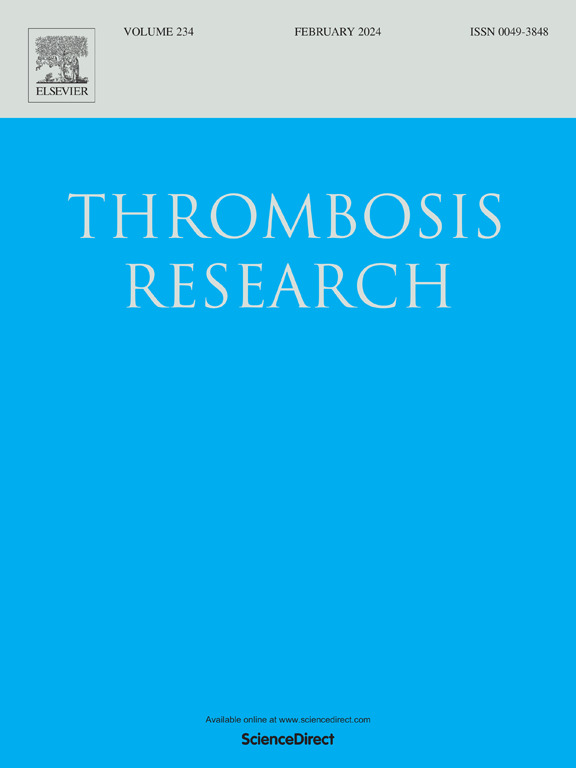Real-world safety and effectiveness of rurioctocog alfa pegol in 338 patients with hemophilia A in South Korea: A postmarketing surveillance study
IF 3.4
3区 医学
Q1 HEMATOLOGY
引用次数: 0
Abstract
Introduction
Rurioctocog alfa pegol is a recombinant coagulation factor VIII (FVIII) with an extended half-life versus the parent product. Limited real-world data exist on the treatment of hemophilia A with rurioctocog alfa pegol in South Korea. This postmarketing surveillance study assessed its safety and effectiveness in a real-world setting, according to Korean regulatory requirements.
Methods
In this prospective, multicenter study (NCT03824522), data were collected from medical records of patients, including children, with hemophilia A receiving rurioctocog alfa pegol as standard clinical practice in South Korea. Safety (adverse events [AEs], adverse drug reactions [ADRs], and unexpected AEs/ADRs) and hemostatic effectiveness were analyzed.
Results
In total, 338 patients were included (mean age [range], 25.0 [1.0–61.0] years; children <12 years, n = 54 [16 %]; all had a history of FVIII treatment). AEs occurred in 20 (5.9 %) patients (unexpected AEs, n = 18 [5.3 %]; ADRs, n = 4 [1.2 %]; unexpected ADRs, n = 2 [0.6 %]; serious AEs, n = 4 [1.2 %]; serious ADRs, n = 0 [0.0 %]). Among children, AEs occurred in 1 (50 %) and 6 (11.5 %) patients aged <2 and ≥2 to <12 years, respectively. No new safety signals were observed. No bleeding events occurred in 239 (76.1 %) patients on prophylaxis. Hemostatic effectiveness was rated by physicians as excellent/good in most patients. Bleeding events were managed with 1–2 infusions. Treatment effectiveness was maintained in children during the study period. No patients developed inhibitor antibodies against rurioctocog alfa pegol.
Conclusion
Rurioctocog alfa pegol was effective in children and adults, with no new safety signals; most patients on prophylaxis experienced no bleeds during the study.
ruurioctocog alfa pegol在韩国338例A型血友病患者中的安全性和有效性:一项上市后监测研究
rurioctocog alfa pegol是一种重组凝血因子VIII (FVIII),与母体产物相比,其半衰期延长。在韩国,rurioctocog alfa pegol治疗血友病A的实际数据有限。根据韩国监管要求,该上市后监测研究评估了其在现实环境中的安全性和有效性。方法在这项前瞻性、多中心研究(NCT03824522)中,收集了包括儿童在内的A型血友病患者的医疗记录数据,这些患者在韩国接受ruurioctocog alfa pegol作为标准临床实践。安全性(不良事件[ae]、药物不良反应[adr]、意外的ae / adr)和止血效果分析。结果共纳入338例患者,平均年龄[范围]:25.0[1.0 ~ 61.0]岁;儿童<;12岁,n = 54 [16%];均有FVIII治疗史)。20例(5.9%)患者发生ae(意外ae, n = 18 [5.3%];adr, n = 4 [1.2%];意外不良反应,n = 2 [0.6%];严重ae, n = 4 [1.2%];严重不良反应,n = 0[0.0%])。在儿童中,2岁和≥2 ~ 12岁的患者分别有1例(50%)和6例(11.5%)发生ae。没有观察到新的安全信号。239例(76.1%)患者未发生出血事件。大多数患者的止血效果被医生评为优秀/良好。出血事件通过1-2次输注处理。在研究期间,儿童的治疗效果保持不变。没有患者产生抗rurioctocog α - pegol的抑制剂抗体。结论鲁里奥斯托克对儿童和成人均有效,无新的安全信号;大多数接受预防治疗的患者在研究期间没有出血。
本文章由计算机程序翻译,如有差异,请以英文原文为准。
求助全文
约1分钟内获得全文
求助全文
来源期刊

Thrombosis research
医学-外周血管病
CiteScore
14.60
自引率
4.00%
发文量
364
审稿时长
31 days
期刊介绍:
Thrombosis Research is an international journal dedicated to the swift dissemination of new information on thrombosis, hemostasis, and vascular biology, aimed at advancing both science and clinical care. The journal publishes peer-reviewed original research, reviews, editorials, opinions, and critiques, covering both basic and clinical studies. Priority is given to research that promises novel approaches in the diagnosis, therapy, prognosis, and prevention of thrombotic and hemorrhagic diseases.
 求助内容:
求助内容: 应助结果提醒方式:
应助结果提醒方式:


